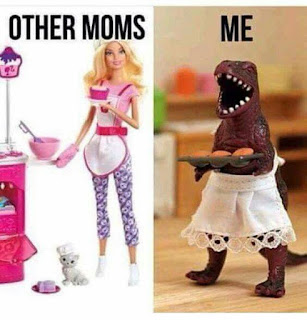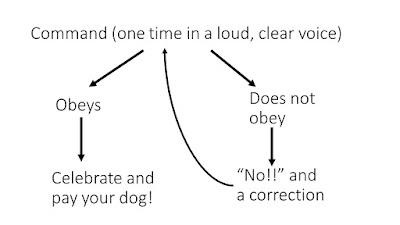Avoiding The 'Chihuahua Syndrome': Repeating Your Commands Over and Over
Avoiding The 'Chihuahua Syndrome':
Repeating Your Commands Over and Over
Ineffectual repeating is probably the most common dog handling mistake I see in my career. "Fluffy, Fluffy...Fluffy, sit, sit sit sit sitsitsitsitsit...etc." People will repeat their dog's name over and over and then the command over and over. They start to sound like the yappy Chihuahua dogs (no offense
Chihuahua owners- I like to say that Chihuahuas are so hooah, they're hooah twice (this is a good thing). If you're bored look on hooah/HUA/hoorah on a military jargon site. If you have Chihuahua, you might have time to look up silly things like this. Disclaimer: we love our double-hua friends too). Eventually this turns into frustration and either throwing in the towel, or screaming the command at the dog. Neither is a good option. What can we do about this, Sammy the Dog Trainer? Well, there are a few things.
Chihuahua owners- I like to say that Chihuahuas are so hooah, they're hooah twice (this is a good thing). If you're bored look on hooah/HUA/hoorah on a military jargon site. If you have Chihuahua, you might have time to look up silly things like this. Disclaimer: we love our double-hua friends too). Eventually this turns into frustration and either throwing in the towel, or screaming the command at the dog. Neither is a good option. What can we do about this, Sammy the Dog Trainer? Well, there are a few things.
 |
| Other dog moms and me... |
Enunciate. Not scream. Dogs do not scream at each other. Also, dogs are very good at sensing mental instability, and so when you start screaming at them, they start looking for the exit. Dogs do bark at each other, however. When I command a dog, I use a loud, clear, enunciated command. If your dog does not understand he is supposed to do something, it is not fair to be disappointed when he does not. When I command, it is close to too loud. I definitely would not converse in this decibel level unless I was talking to someone who is hard of hearing. Also I keep the command short and abrupt. SIT not SIIIIIIIIIIIT. Short. Abrupt. Loud. Enunciated. Not screaming or crazy. You can make it sound happy and exciting as well as loud. Shouting COME at your dog like Darth Vader is not going to be super inviting, so find the balance between loud and I'm-going-to-eat-your-brain. The goal is happy loud. Research studies actually support excited tones to motivate your dog (see Bray, MacLean, & Hare, 2015).
I only use one or two word commands. Do not use a full sentence. Do not ask your dog is she wants to sit down, pretty please? I use words that are easily distinguishable and also use intuitive hand signals to aid the dog. Some dogs are auditory learners and some are visual learners (D'aniello et al, 2016), so I use a hand signals as well as the verbal cue to satisfy both learning methods. Use intuitive hand signals- a big stop sign hand is intuitive for STAY. Jumping up and doing and rolling on the ground is not so intuitive for STAY.
Do not repeat your dog's name over and over. Once is sufficient. What is he is not looking at you even after you say his name? The answer is, it does not matter. Some dogs will not look at you even if they are listening to you. Proceed with your command. It's on him to be paying attention if you give him a command. A lot of dogs will not stare at you all the time because it can be confrontational. Other dogs might be more apt to stare at you because they have a built in staring-mechanism (drover dogs like Border Collies, for instance, herd by eye contact, so they tend to look more intensely at their objects of interest than other dogs). How will you know if your dog is paying attention? Easy- if you give him a command and he ignores you, he is not paying attention.
What do I do if my dog ignores me after I give him a command? First, I make sure I wait a sufficient amount of time for the dog to respond. Dog trainers will say an adult dog takes about 1.5 seconds to decide whether or not he would follow through with a command he knew well. This extends, obviously, for new commands or for younger puppies. Count that off in your head. One one thousand two one thousand...it is actually quite a bit longer than you would expect. So be still and patient while your dog thinks. Do not move around, do not talk. Just be still and wait.
After the 1.5 seconds, what if he still has not done it? Then, I correct the dog (humanely and firmly) and say NO at the same time. How can I correct my dog? That is a loaded question. There are a lot of ways to correct behaviors, but for the purposes of obedience, let us say we are going to use a leash tug. Now, if you walk your dog on a flat collar or have a dog prone to respiratory issues, you have to be careful with this. Do not yank your dog around. If Fluffy's feet are flying off the ground, you are pulling too hard. The leash pop is meant to be quick and startling, not painful. Consider a harness or training collar if you are concerned about your dog's trachea. Quick pop and release, while barking NO at the same time. Then give the command again, ONE TIME. Here is a decision tree to help you:
The key is to keep following the decision tree...even if your dog does not sit for twenty repetitions. You cannot give up. You cannot get frustrated. I have spent hours of my life (not usually in one go around but cumulatively) saying "No. Sit....No. Sit....No. Sit..." You must win the battle. Your dog must be convinced that you will all starve to death unless he does the command. Your life gets easier after you win a couple battles. Now, if your dog is learning something new, obviously do not correct her harshly or be super harsh with your No's. IF I say No at all when a dog is learning something new, it is gentle and in a "try again partner" tone. This is usually after the dog wanders off and starts chasing butterflies. Sometimes I wish I could wander off and chase butterflies too.
 |
| © Copyright 2018 |
Alright, that seems easy, Sammy. Why do I even pay you? Hahaha, go try it. Oh wait! It is actually tougher in practice. Dog handling is an art and a skill. It requires coaching to hone. It requires practice to get rid of the Sitsitsitsitsitsitsitsit habit. I had to practice with an imaginary dog at first, to get my "Command...No + leash pop. Command." sequence down. Again, do not yank your dog around. No flying dogs. Ask your trainer if you are not sure about the amount of pressure, or a good fit for a collar for your particular dog (yes collar selections are different for different types of dogs...a blog for another day). If you do not have a trainer, give me call!
Now go forth and conquer!
-Sammy the Dog Trainer
References
Bray, E.E., MacLean, E.L. & Hare, B.A. (2015) Anim Cogn 18: 1317. https://doi.org/10.1007/s10071-015-0901-1
D'aniello, B., Scandurra, A., Alterisio, A., Valsecchi, P., & Prato-previde, E. (2016). The importance of gestural communication: A study of human-dog communication using incongruent information. Animal Cognition, 19(6), 1231-1235. http://dx.doi.org.library.capella.edu/10.1007/s10071-016-1010-5









Comments
Post a Comment